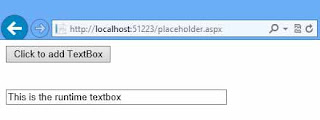There are 2 ways in which to figure with the hypertext mark-up language controls; initial, by exploitation them as hypertext mark-up language client controls and handling their respective events events at the client-side, and second, by running these controls at the server-side and handling the events of the hypertext mark-up language controls within the code-behind file exploitation any programming language supported by .NET Framework, like C# or Visual Basic. during this former case, you want to use a scripting language, like JavaScript. for handling events and performing validations. exploitation hypertext mark-up language controls as client controls is additionally the default style of hypertext mark-up language controls. However, html controls support limited events that may be handled on the server, for instance, the events like onblur, onfocus, and onhelp are available at the client-side however not at the server-side.
HTML controls are present within the under or Visual Studio beneath a tab named hypertext mark-up language. you'll handle the events in hypertext mark-up language presentation code using a scripting language, like JavaScript. an hypertext mark-up language control is became an hypertext mark-up language server management by adding the runat="server" attribute to that. depending on the necessities, an hypertext mark-up language control is used as client-side control or server-side management. as an example, an hypertext mark-up language control is used as a client-side control once you need to handle the events of hypertext mark-up language controls victimization client resources. On the opposite hand, if you wish the controls to show information from server and separate the hypertext mark-up language presentation code from application logic code, then you ought to use the hypertext mark-up language control as a server side control.
By default, HTML control is a client-side control and can be used for scripting in the Web page only. ASP.NET IDE provides a unique identity to each control that you can use to refer the control in your script code. The control's ID is available with the id property in the properties window. You can change the ID of any control as per your requirement. Since ID refer to the unique identity of every control, every control must have a separate ID.
Even if you turn the HTML control into server -side control, it will continue to use the status default ID that is provided to it by ASP.NET IDE . Naming of HTML controls is different from that of ASP.NET controls. For example, the default ID of a TextBox control in ASP.NET is TextBox1, whereas for an HTML control, it would be Text1.
HTML server controls have no AutoPostBack property , which means that events have to wait to be raised by the user. Suppose you create a Submit button and add the runat="server" attribute to it. Now, the page is not processed unless the Submit button is clicked.
HTML controls are present within the under or Visual Studio beneath a tab named hypertext mark-up language. you'll handle the events in hypertext mark-up language presentation code using a scripting language, like JavaScript. an hypertext mark-up language control is became an hypertext mark-up language server management by adding the runat="server" attribute to that. depending on the necessities, an hypertext mark-up language control is used as client-side control or server-side management. as an example, an hypertext mark-up language control is used as a client-side control once you need to handle the events of hypertext mark-up language controls victimization client resources. On the opposite hand, if you wish the controls to show information from server and separate the hypertext mark-up language presentation code from application logic code, then you ought to use the hypertext mark-up language control as a server side control.
By default, HTML control is a client-side control and can be used for scripting in the Web page only. ASP.NET IDE provides a unique identity to each control that you can use to refer the control in your script code. The control's ID is available with the id property in the properties window. You can change the ID of any control as per your requirement. Since ID refer to the unique identity of every control, every control must have a separate ID.
Even if you turn the HTML control into server -side control, it will continue to use the status default ID that is provided to it by ASP.NET IDE . Naming of HTML controls is different from that of ASP.NET controls. For example, the default ID of a TextBox control in ASP.NET is TextBox1, whereas for an HTML control, it would be Text1.
HTML server controls have no AutoPostBack property , which means that events have to wait to be raised by the user. Suppose you create a Submit button and add the runat="server" attribute to it. Now, the page is not processed unless the Submit button is clicked.






